● ● ●
NOTE ON UNIT
NOMENCLATURE
By the
late 1930s tank battalions of the British Army were either
former horse cavalry regiments or belonged to the Royal Tank
Regiment (RTR). The cavalry retained their traditional
titles, e.g. King’s Dragoon Guards, 1st Northamptonshire
Yeomanry. They also retained the designation regiment
even though they were battalion-sized units. Tank battalions
belonging to the RTR were numbered, e.g. 1st Battalion,
Royal Tank Regiment, usually abbreviated to 1st RTR.
● ● ●
At the
end of the Great War, conventional military opinion held
that the tank, though it had proved useful, would
nevertheless remain an adjunct to the infantry. Existing
tanks were slow, unmaneuverable and mechanically unreliable.
Only a small minority of imaginative military thinkers
envisioned the tank as the decisive weapon on future
battlefields and they were mostly disregarded—the more so as
the conflict just concluded was widely thought to have been “the war
to end war.”
Only in
Britain, the birthplace of the tank, did there exist an
institutional framework for the development of armored
warfare concepts: the Royal Tank Corps (RTC; later the Royal
Tank Regiment) of the British Army. In the beginning, not all
of the “tank prophets” were in agreement as to the tank’s
proper role in a future war. Some, like Colonel J.F.C
Fuller, thought that the tank could function independently
as a “land ironclad”; others believed that the tank should
form part of a mechanized all-arms battle group including
infantry, artillery, engineers, etc. equipped with
specialized armored vehicles of their own. Prominent among
the latter faction was Captain B.H. Liddell Hart, a former
Army officer, invalidated out of the service after being
severely wounded on the first day of the Battle of the
Somme. As a military commentator and journalist with many
contacts in the Army, he was well
placed to spread the gospel of the tank and became its
foremost proponent, far better known than serving RTC
officers such as Fuller, Hobart and Martel, who worked
within the system.
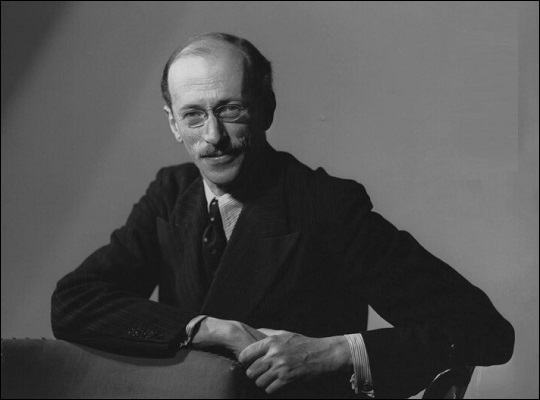
Prophet of armored
warfare: Sir Basil Henry
Liddell Hart (National Portrait Gallery)
Parsimonious peacetime military budgets and the skepticism
of orthodox soldiers limited the RTC’s ability to try out
its ideas, but in 1927 an Experimental Mechanized Force (EMF)
was formed for that purpose. The EMF was a brigade-sized
unit combining light and medium tanks, armored cars,
motorized infantry and engineers, and motor-towed field
artillery. Colonel Fuller was offered the command, but as
the War Office refused to meet his requirements for an expanded
staff, he resigned and went into retirement. The command was
given instead to Brigadier R. J. Collins, an infantry
officer, and in the 1928 Eastland/Westland war game, the EMF
proved its worth. Eastland/Westland and subsequent field
exercises enabled tank tactics to be refined, and drew
attention to many practical requirements of mechanized
warfare: reconnaissance, communications, supply, maintenance. It was
particularly noted that tanks should be equipped with radios
to facilitate tactical control.
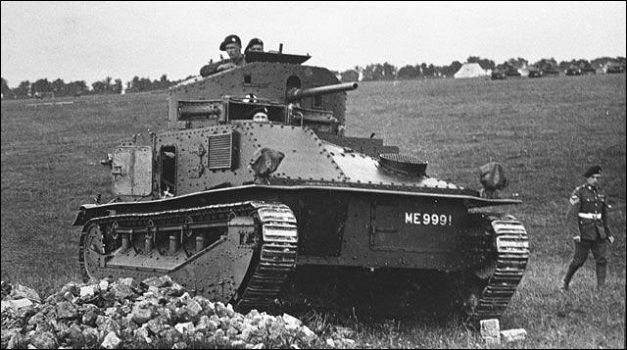
A Mark II Medium Tank of
the EMF in 1927 (Imperial War Museum)
In 1928
the EMF was renamed the Armoured Force (AF) and in 1933 a
permanent armored brigade was established. This led to the
formation of the Mobile Division (later the 1st Armoured
Division) in the UK (1937) and the Mobile Force (later the
7th Armoured Division) in Egypt (1938). The commander of the
Mobile Force was Major-General Sir Percy Hobart, the British
Army's leading tank expert, who had previously commanded the
1st Armoured Brigade and served as Inspector of the RTC. But
by this time the British Army, which pioneered armored
warfare concepts in the 1920s and early 1930s, had
surrendered its lead to Germany. This was due partly to
insufficient funding and partly to the innate conservatism
of the British Army.
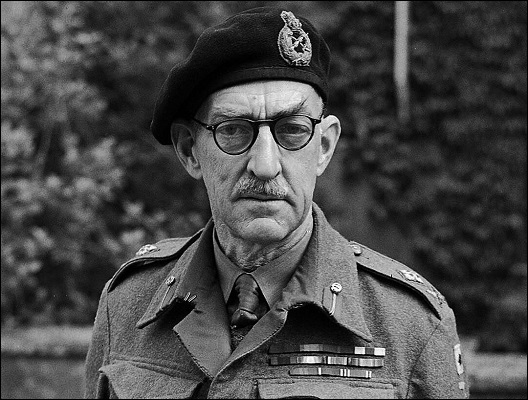
Major-General Sir Percy
Hobart during World War II (Imperial War Museum)
It was
not that senior officers refused to accept the necessity of
mechanization. They admitted that the Army’s prestigious
cavalry regiments must replace their horses with tanks and
armored cars. What did not change, however, was the cavalry
mind-set. If tanks must replace horses, nevertheless they
would be employed in the traditional cavalry manner:
operating en masse to fight opposing armored
formations, exploit breakthroughs, and pursue retreating
enemy forces. But the infantry support mission was seen in
quite a different light: tanks operating in small groups,
moving at the pace of the infantry, much as tanks had
operated during the Great War. Thanks to this division
of roles and missions, neither the RTC nor the Royal
Armoured Corps, set up in 1939 to administer all armored
units, ever succeeded in evolving a unified mechanized
warfare doctrine.
British
tank design thus proceeded on two tracks. The cavalry would
be equipped with light tanks and “cruiser” tanks, both fast
and lightly armored, the former armed with machine guns, the
latter armed with a 2-pounder (40mm) antitank gun (ATG) plus
machine guns. Tanks for infantry support—“I” tanks as they
were designated—would be relatively slow and well armored,
armed with a 2-pounder ATG plus a machine gun.
Organizationally, the light tank and cruiser tank battalions
would be used to form armored divisions, while the infantry
tank battalions would be used to form tank brigades. Light
tanks would also equip the armored reconnaissance battalions
of infantry divisions and the corps armored reconnaissance
brigades. With a few exceptions, light and cruiser tank
battalions were cavalry units while infantry tank battalions
were part of the Royal Tank Regiment—as the RTC was retitled
in early 1939.
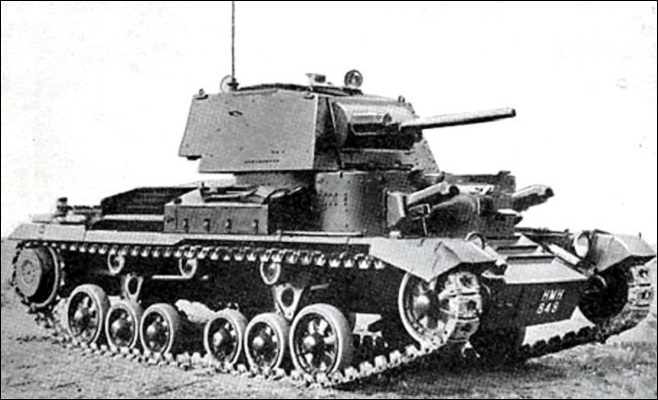
The Mk I (A9) Light
Cruiser Tank (Tank Encyclopedia)
The
British Army’s failure to group all armored units in a
single arm of service, as happened in Germany, had
unfortunate effects on both tank design and tactical
doctrine. The Mk I (A9) cruiser tank, which entered service
in 1939, was certainly fast and its 2-pounder ATG was an
effective weapon, but its armor was altogether inadequate.
The Mk I was followed into service by the Mk II (A10),
originally intended to serve as an infantry tank. Judged
unsuitable for that role, it was reclassified as a “heavy
cruiser tank”—this reflecting its thicker armor and lower
speed compared with the Mk I, now classified as a “light
cruiser tank.” There were close support (CS) versions of
both tanks, armed with a 3.7-inch howitzer in place of the
2-pounder ATG. The CS tank was intended to support other
tanks in action, primary by firing smoke shell to shield
their movements. The light tank was the Mk VI, armed with
one caliber .50 and one caliber .303 machine gun.
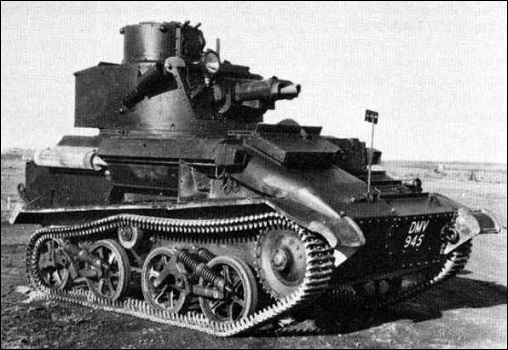
The Mk VI Light Tank (Tank
Encyclopedia)
None of
these tanks met the criteria for what nowadays would be
called a main battle tank, i.e. a tank whose firepower,
armor protection and mobility enable it to perform any
mission. But the deficiencies of British tanks were less
important than the faulty tactical doctrine governing their
employment on the battlefield.
Organizationally, the first British armored divisions had
too many tanks and too little infantry. On the eve of war in
1939, the 1st Armoured Division had some 275 light, cruiser
and CS tanks in two light and one heavy armored brigades,
each with three battalions. A support group embodied two
motorized infantry battalions, two field artillery
battalions (motor towed), a motorized engineer battalion and
a battery of 2-pounder ATG (motor towed). The Armoured
Division (Egypt) was incomplete, with only one light and one
heavy armored brigade, a reconnaissance battalion with
wheeled armored cars, a single motorized infantry battalion
and one battery each of field artillery and ATG, both
motor towed. Thus the tanks could count on very little by
way of infantry and artillery support, and combined
arms tactics, integrating the action of tanks, infantry and
artillery, were largely disregarded. But these disadvantages
were not recognized, for it was thought that tanks, massed
in large formations, could fight on their own in the old
cavalry style. War experience, particularly in North Africa,
was to show just how wrong that idea was.
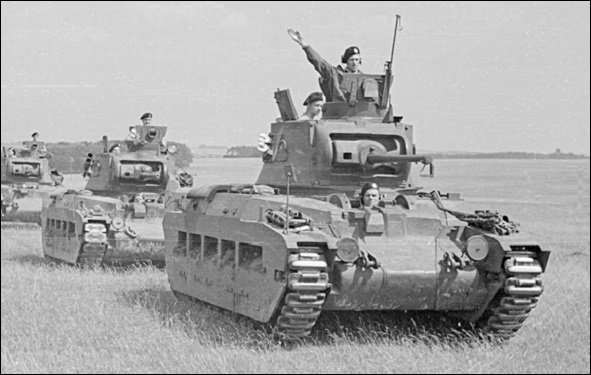
Mk II (A12) Matilda
Infantry Tanks (Imperial War Museum)
As for
the infantry tanks, by 1939 they were grouped in brigades,
each with three battalions, for a total of 151 “I” tanks and
21 light tanks. The first “I” tank was the Mk I (A11)
Matilda, armed with a machine gun only. Its replacement, the
Mk II (A12) Matilda, armed with the 2-pounder ATG and a
machine gun, was just beginning to enter service—only two
had been delivered by September 1939. Though slow, the Mk II
Matilda was the best tank in the British Army’s inventory at
the beginning of World War II. Its armor was impervious to
any antitank gun in service and its gun could
penetrate the armor of any German or Italian tank.
A
shortcoming common to both cruiser tanks and the Mk II
Matilda was that their main armament, the 2-pounder ATG, was
not provided with high-explosive ammunition. If could fire
only solid AT shot, which was useless for any other purpose.
Though perhaps understandable in the case of the cruiser
tanks, this was a strange oversight indeed in a tank
designed to support the infantry.
That
Britain, the birthplace of the tank, failed to capitalize on
the pioneering work of the tank prophets and the EMF is a
sad irony of military history. But the mechanization of the
cavalry, necessary though it was, effectively dissipated the
authority of the RTR, where the tank prophets and their
successors had found their natural home. And the
parochialism inherent in the British Army’s regimental
system compounded the problem. Though the cavalry horse was
retired, the cavalry regiments and the cavalry tradition
survived. Gallantry and dash were honored above close study
and application of tank tactics; the more professional
outlook of the RTR was disregarded if not scorned. But the
maintenance of those cherished cavalry traditions proved
costly, and the bill was to come due in North Africa. Against the
Italians British tanks prevailed, but the advent of Rommel
and his Afrika Korps
exposed the deficiencies of the British Army’s armored
forces in a most painful manner.
● ● ●